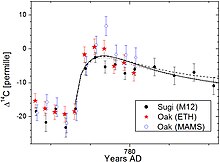774年至775年間碳14飆升

774年至775年間碳14飆升是指在公元774年至775年間,樹木年輪中碳14(14C)的濃度增長了1.2%,是普通的背景小幅度波動的20倍。 研究人員在研究日本柳杉時發現了這一現象,隨後依照樹輪年代學的有關理論確定了該現象具體的發生時間。[2]此外,在南極冰層的核心地帶檢測出了鈹的同位素10Be的激增,這一現象也與774年至775年間發生的事件相關。[1]
該現象似乎在全球都有發生,在德國、俄羅斯、美國和新西蘭樹木的年輪中都有類似的碳14飆升的現象存在。[1][3][4]
碳14的濃度激增了約1.2%,隨後又逐漸減少(見右圖)。這種模式和大氣中碳14濃度突然增多表現出的模式很接近,[1]暗示出這是一次突發事件。經計算,此次事件期間,全球碳14的產量為Q= (1.1至1.5)×108 原子/cm2。[1][5][6]
假說[編輯]

目前,對於事件的發生,人們有幾種不同的解釋。
公元774年。在這一年中的復活節季,諾森布里亞人將他們的國王阿爾萊德從約克放逐;他們擁立了摩爾之子埃塞雷德為王,讓他統治了四個春秋。這一年垂暮的天空中也出現了一個紅色的十字架;麥西亞人和肯特人在奧特福德交戰;在南撒克遜人的土地上,人們也看到了些奇妙的蛇。[注 1]
——《盎格魯-撒克遜編年史》[7]
根據《盎格魯-撒克遜編年史》的記載,774年間,英國的天空中出現了「紅色的十字架」。鑑於人們沒有發現超新星爆發的痕跡,「紅色的十字架」被認為是極光。[1]
中國也沒有關於770年代中期極光的史料記載,只有在762年有極光的記錄。770年代的彗星觀測也與預期的大氣現象不符。[8]相反,根據記載,775年發生了一場異常的「雷暴」。[9]
最常見的一種說法是,這次的碳14飆升是一場強烈的太陽耀斑引發的太陽粒子事件所造成的。這場太陽耀斑可能是有史以來最強烈的一次,但仍在太陽的極限以內。[1][5][10][11][12]此外也有人提出過伽瑪射線暴的可能性,[6][13]但這似乎不太可能,因為同位素10Be和36Cl的濃度水平也出現了和碳14類似的情形。[12]
類似事件發生的頻率[編輯]
在宇宙同位素的記錄中,774年的這次事件是在過去的1.1萬年間最強烈的一次,[10]但絕非前無古人後無來者。公元993年至994年期間發生了類似的事情,但是強度只有774年到775年的0.6倍。[14]此外,人們懷疑類似的事件在全新世年代也有發生。[10]
從這些統計數據中,人們可能會估計這種事情可能上萬年才能發生一回,而稍微輕微一些的可能每一千年、每個世紀都會發生。774年的這次事件並沒有對地球生命造成多大的損害,[11]但是如果它在現代社會中發生的話,很可能會對現代科技造成極大的破壞,首當其衝的就是通訊行業和衛星導航系統。此外,太陽耀斑所造成的這些同位素的變化也會給太空人造成危險。[15]
參見[編輯]
腳註[編輯]
- ^ 原文:«Annus Domini 774. This year the Northumbrians banished their king, Alred, from York at Easter-tide; and chose Ethelred, the son of Mull, for their lord, who reigned four winters. This year also appeared in the heavens a red crucifix, after sunset; the Mercians and the men of Kent fought at Otford; and wonderful serpents were seen in the land of the South-Saxons».
參考文獻[編輯]
- ^ 1.0 1.1 1.2 1.3 1.4 1.5 1.6
Usoskin, I. G.; et al. The AD775 cosmic event revisited: The Sun is to blame. Astronomy & Astrophysics. 2013, 552 (1): L3. Bibcode:2013A&A...552L...3U. arXiv:1302.6897
 . doi:10.1051/0004-6361/201321080.
. doi:10.1051/0004-6361/201321080.
- ^ Miyake, F.; Nagaya, K.; Masuda, K.; Nakamura, T. A signature of cosmic-ray increase in AD 774–775 from tree rings in Japan. Nature. 2012, 486 (7402): 240–242. Bibcode:2012Natur.486..240M. PMID 22699615. doi:10.1038/nature11123 (英語).
- ^ Jull, A.J.T.; Panyushkina, I.P.; Lange, T.E.; et al. Excursions in the 14C record at AD 774-775 in tree rings from Russia and America. Geophys. Res. Lett. 2014, 41: 3004–3010. Bibcode:2014GeoRL..41.3004J. doi:10.1002/2014GL059874.
- ^ Güttler, D.; Beer, J.; Bleicher, N. The 774/775 AD event in the southern hemisphere. Annual report of the laboratory of ion beam physics (ETH-Zurich). 2013.
- ^ 5.0 5.1
Melott, A.L.; Thomas, B.C. Causes of an AD 774-775 C increase. Nature. 2012, 491: E1. Bibcode:2012Natur.491E...1M. PMID 23192153. arXiv:1212.0490
 . doi:10.1038/nature11695.
. doi:10.1038/nature11695.
- ^ 6.0 6.1
Pavlov, A.K.; Blinov, A.V.; Konstantinov, A.N.; et al. AD 775 pulse of cosmogenic radionuclides production as imprint of a Galactic gamma-ray burst. Mon. Not. R. Astron. Soc. 2013, 435: 2878–2884. Bibcode:2013MNRAS.435.2878P. arXiv:1308.1272
 . doi:10.1093/mnras/stt1468.
. doi:10.1093/mnras/stt1468.
- ^ Nancy Owano. Red Crucifix sighting in 774 may have been supernova. Phys.org. 2012-06-30 [2017-05-07]. (原始內容存檔於2013-09-04).
- ^ Chapman, J.; Neuhäuser, D.L.; Neuhäuser, R.; Csikszentmihalyi, M. A review of East Asian reports of aurorae and comets circa AD 775. Astronomische Nachrichten (WILEY-VCH Verlag). 2015, 336 (6): 530–544. Bibcode:2015AN....336..530C. doi:10.1002/asna.201512193.
- ^ Chai, Ya-Ting; Zou, Yuan-Chuan. Searching for events in Chinese ancient records to explain the increase in C from AD 774–775 and AD 993–994. Research in Astronomy and Astrophysics. 2015-09, 15 (9): 1504–1512. doi:10.1088/1674-4527/15/9/007.
- ^ 10.0 10.1 10.2
Usoskin, I.G.; Kovaltsov, G.A. Occurrence of Extreme Solar Particle Events: Assessment from Historical Proxy Data. Astrophys. J. 2012, 757: 92. Bibcode:2012ApJ...757...92U. arXiv:1207.5932
 . doi:10.1088/0004-637X/757/1/92.
. doi:10.1088/0004-637X/757/1/92.
- ^ 11.0 11.1
Thomas, B. C.; Melott, A. L.; Arkenberg, K. R.; Snyder, B. R. Terrestrial effects of possible astrophysical sources of an AD 774-775 increase in 14C production. Geophysical Research Letters. 2013, 40 (6): 1237. Bibcode:2013GeoRL..40.1237T. arXiv:1302.1501
 . doi:10.1002/grl.50222.
. doi:10.1002/grl.50222.
- ^ 12.0 12.1 Mekhaldi; et al. Multiradionuclide evidence for the solar origin of the cosmic-ray events of ᴀᴅ 774/5 and 993/4. Nature Communications. 2015, 6: 8611. Bibcode:2015NatCo...6E8611M. PMC 4639793
 . PMID 26497389. doi:10.1038/ncomms9611.
. PMID 26497389. doi:10.1038/ncomms9611.
- ^
Hambaryan, V. V.; Neuhauser, R. A Galactic short gamma-ray burst as cause for the 14C peak in AD 774/5. Monthly Notices of the Royal Astronomical Society. 2013, 430 (1): 32–36. Bibcode:2013MNRAS.430...32H. arXiv:1211.2584
 . doi:10.1093/mnras/sts378.
. doi:10.1093/mnras/sts378.
- ^ Miyake, F.; Masuda, K.; Nakamura, T. Another rapid event in the carbon-14 content of tree rings. Nature Communications. 2013, 4: 1748. Bibcode:2013NatCo...4E1748M. PMID 23612289. doi:10.1038/ncomms2783.
- ^ Townsend, L. W.; Porter, J. A.; deWet, W. C; Smith, W. J.; McGirl, N. A.; Heilbronn, L. H.; Moussa, H. M. Extreme solar event of AD775: Potential radiation exposure to crews in deep space. Acta Astronautica. Special Section: Selected Papers from the International Workshop on Satellite Constellations and Formation Flying 2015. 2016-06-01, 123: 116–120 [2017-05-07]. doi:10.1016/j.actaastro.2016.03.002. (原始內容存檔於2017-09-09).
